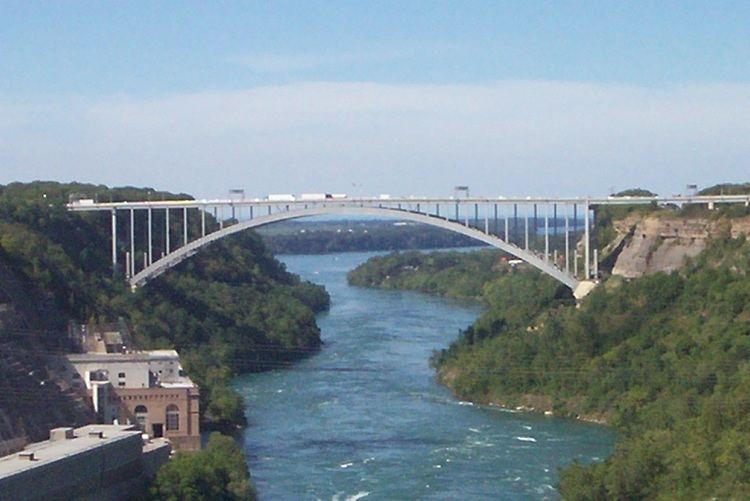Total length 1,594 feet (486 m) Opened 1 November 1962 | Construction started 1850 Height 85 m Bridge type Arch bridge | |
 | ||
Address Robert Moses State Pkwy, Lewiston, NY 14092, USA Toll 3.5 USD ($3.25 with ExpressPass, westbound only) Similar Rainbow Bridge, Peace Bridge, Whirlpool Rapids Bridge, Sir Adam Beck Hydroele, Niagara Gorge | ||
The Lewiston–Queenston Bridge, also known as the Queenston–Lewiston Bridge, is an arch bridge that crosses the Niagara River gorge just south of the Niagara Escarpment. The bridge was officially opened on November 1, 1962. It is an international bridge between the United States and Canada. It connects Interstate 190 in the town of Lewiston, New York to King's Highway 405 in the community of Queenston, Ontario. The Lewiston–Queenston Bridge is a replica of the Rainbow Bridge at Niagara Falls.
Contents
Customs plazas are located on both ends of the bridge, with tolls only being charged on entering Canada (USD$3.50 or CAD$4.50 per automobile as of Dec. 15, 2015). The bridge accepts E-ZPass electronic toll collection and houses the second Canadian E-ZPass collection facility, after the nearby Peace Bridge. Also, two duty-free stores are located between the two plazas.
The bridge permits no pedestrians, but licensed taxi service is permitted. The Lewiston–Queenston Bridge lacks expedited border clearance facilities for NEXUS and FAST card holders traveling from Canada to the United States, but does have a NEXUS lane for travel into Canada.
Gantries have lights indicating the direction of traffic as the lanes are reversible. Speed limit is posted in kilometres and miles per hour (15 mph or 24 km/h limit) along the bridge. A set of flags, Canada and United States, are found at the midpoint on the south side of the bridge.
Toll plaza
There are toll plazas for customs clearance on either side of the bridge. The toll plaza for payment for use of the bridge is on the Canadian side only.
High mast lighting is used on the Canadian side with regular light standards used for bridge and US toll plaza.
Previous suspension bridges
The current arch bridge replaced an old suspension bridge called the Queenston-Lewiston Bridge which was located seven-tenths mile (1.1 km) north. Coincidentally, the suspension bridge was originally built near the location of the present-day Rainbow Bridge, and was moved to Queenston in 1898 by R.S. Buck and engineer L.L. Buck, after the completion of the Rainbow Bridge's predecessor, the Upper Steel Arch Bridge. The suspension bridge was dismantled in 1963.
There are a couple of reminders of the earlier bridge. First are two columns that lie within the Earl W. Brydges Artpark State Park. Second is the original brass plaque, now located midspan alongside the road, right at the border between the two countries. The plaque is flanked by a US and a Canadian flag.
The supports are part of Owen Morrell's Omega, a steel sculpture and observation platform added in 1981. Two columns remain are found on the Canadian side at the foot of York Street in a wooded area now known as York Park.
The first Queenston-Lewiston Bridge was built in 1851 by engineer Edward Serrell and wrecked by wind in 1864 (or 1854). Some of the cables were still in place as late as 1895. The road deck span was about 841–849 ft (256–259 m). The suspension bridge design was unusual because the cables were attached to the cliff with only small towers. This made the road deck span shorter than the cable span of 1,040 feet (317 m).
